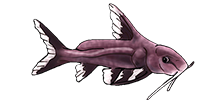Bockmann, FA & I Sazima, 2004. Trichomycterus maracaya, a new catfish from the upper rio Paraná, southeastern Brazil (Siluriformes: Trichomycteridae), with notes on the T. brasiliensis species-complex. Neotropical Ichthyology 2: 61-74.
Abstract
Trichomycterus maracaya, a new species of Trichomycteridae, is described from a streamlet in the upper rio Paraná, Poços de Caldas, State of Minas Gerais, southeastern Brazil. The following putative autapomorphies distinguishes T. maracaya from congeneric species: 1) row of lateral blotches not forming a stripe at any phase during ontogeny; 2) superficial layer of pigmentation of juveniles and large (presumably adults) specimens consisting solely of scattered chromatophores. Furthermore, the new species is characterized by a combination of yellow ground color in life and mottled pattern formed by small to medium-sized, brown, irregularly-coalescent, well-defined deeper-lying blotches, and more superficial dots on the body. Trichomycterus maracaya is assigned to the T. brasiliensis species-complex (which includes T. brasiliensis, T. iheringi, T. mimonha, T. potschi, T. vermiculatus, and several undescribed species apparently endemic to the main river basins draining the Brazilian Shield) based on the presence of: 1) blotches in four longitudinal rows of deeper-lying pigmentation on the trunk large, horizontally-elongated, and well-defined;
2) pectoral fin with I+5-6 rays; 3) separation between the anterior and posterior cranial fontanels by the primordial epiphyseal cartilaginous bar being present only in larger specimens; and 4) pelvic-fin bases very close to each other, sometimes in contact.
New Trichomycterus
- Silurus
- Posts: 12420
- Joined: 31 Dec 2002, 11:35
- I've donated: $12.00!
- My articles: 55
- My images: 893
- My catfish: 1
- My cats species list: 90 (i:1, k:0)
- Spotted: 424
- Location 1: Singapore
- Location 2: Moderator Emeritus





